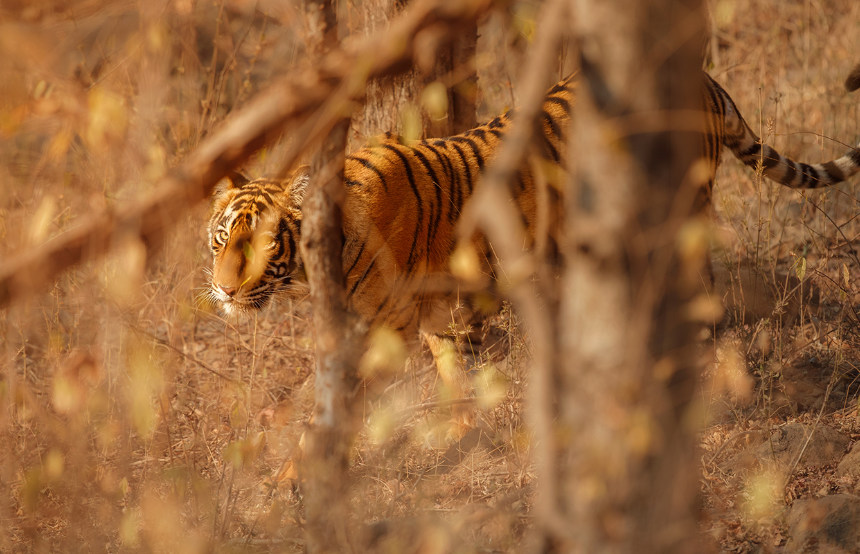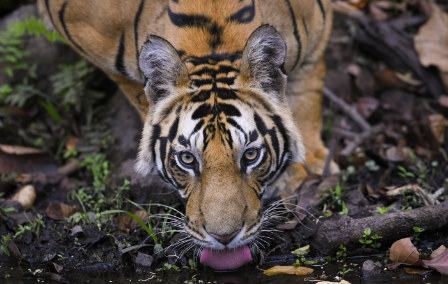Published 15th Jan. 2025
Reading time
While they might not be bush’s biggest cat or a famed member of the ‘Big Five’ animals, the cheetah’s strengths lie elsewhere. These sleek, slender and speedy creatures are a prominent feature of the African landscape, where almost all the remaining cheetah populations can be found (there’s a population of less than 20 in Iran, too). From their breakneck speeds to spectacular spotted coats, read on to discover our favourite cheetah facts…
1. Super-fast felines
2. Adapted animals
3. Marvellous markings
4. Social lives
5. Communication tactics
6. Threatened species
7. Diurnal hunters
8. Dependent cubs
1.
Reaching speeds of up to 70mph, the cheetah is the fastest land animal in the world. It can accelerate from zero to 60mph in just three seconds (that’s faster than most sports cars). Impressive, right? And we’re not done yet. While sprinting at high speeds, a cheetah’s stride can reach almost 23ft long, and they’re also the only big cats able to turn in mid-air. Their swift starts are tricky to sustain, however. Although they’re the fastest felines in the business, cheetahs can only maintain this momentum for a short time; a chase usually lasts less than a minute.

2.
So, how does a cheetah reach such lightning-like speeds? These agile animals have specially adapted bodies to aid their hunting prowess, including a flexible, elongated spine that helps them make tight turns and leaping strides. Cheetahs also boast long, rudder-like tails that aid their mobility at fast speeds and have semi-retractable claws – a novelty among cats – that act like studs on football boots, allowing a firm grip during a chase. Their sporty physiques are complete with enlarged nasal passages and sinuses to increase oxygen intake and keep them cool after a hunt. It’s no wonder their prey doesn’t stand a chance…
3.
Next up on our fascinating list of cheetah facts is their distinctive markings. Each cat has a uniquely spotted fur coat comprising between 2,000 and 3,000 black spots that help them blend into their surroundings. Another clever camouflage is the cheetah’s tail, which ends with a bushy tuft encircled with dark stripes. These tufts are thought to provide a signal for cubs when following their mother through the bush. Sweet. Finally, on their faces, cheetahs have pigmented sections of fur called malar stripes, akin to tear marks, that are believed to safeguard their eyes from the sun’s glare. This serves a hunting purpose: it allows them to focus on prey from long distances away.

Image by Jackie Cole
4.
As big cats go, our favourite felines are pretty social beings. Cheetahs generally hang out in coalitions (their collective noun, not a political alliance) of a mother and her young, a group of siblings or an all-male group. Male coalitions are unusual among mostly solitary large cat species, but they allow cheetahs to defend bigger territories and increase their chance of finding a mate. They like to keep their coalitions in the family, so they’re most often formed of brothers. Adult females, however, usually roam alone. Girl power.
5.
You might expect a list of facts about cheetahs to include one about their fearsome roars. But we’ll let you in on a secret: cheetahs can’t roar. Unfortunately for these (visually) fur-ocious creatures, cheetahs lack the two-piece bone in their throat to rival their fellow big cats’ vocalisations. Yet cheetahs make up for this absence with other clever communication tactics, conversing in their coalitions through hissing, growling, chirping, yelping and purring (the latter of which, unlike with smaller felines, occurs on both their inhale and exhale).

6.
Sadly, the number of cheetahs in the wild is rapidly dwindling, with over 90% disappearing since 1900. As of today, it’s estimated that the global population of cheetahs stands at less than 8,000. Cheetahs have earned a ‘vulnerable’ status on the IUCN Red List for multiple reasons, but their most significant threat is from humans. This includes habitat loss due to encroaching human settlements, the illegal wildlife trade and human conflict. Cheetahs also lack genetic diversity, making them more likely to succumb to disease and environmental changes.
7.
Unlike their fellow big cats, cheetahs use the daylight hours to hunt for their next meal. This makes it less likely they’ll have to fight against nocturnal predators (like hungry hyenas and lions) for their food. Cheetahs’ incredible eyesight allows them to spot prey from approximately three miles away, and their malar stripes (which we learnt about earlier) come in handy against the sun. Despite their best efforts, it’s thought that around ten per cent of a cheetah’s kills are stolen by other predators. You can’t win ‘em all.
8.
Last up on our list of cheetah facts concerns their cute cubs. At birth, cheetah cubs are blind and vulnerable, relying solely on their mothers (hello, absent fathers) to protect them against predators – we're looking at you, lions. Because of this, they have a very high mortality rate, and it’s thought that fewer than one in ten survive past their first few months. To keep them safe, mothers – who raise their young for the first 18 months – frequently move their nest. After around a year, things start looking up, and they join their mother on her hunting escapades…
Written by Hannah Whitehall | Header image by Un Cercle
Practical advice and inspiration for your next trip

Searching for the best safaris in India? We’ve got you covered. Whether you’re keen to track tigers in Madhya Pradesh, admire Asiatic lions in Gujarat or photograph forest eagle owls in Kerala, your India holiday awaits. While Bengal tigers steal the limelight in Bandhavgarh National Park, don’t forget about the shaggy sloth bears (though they’re not as cuddly as they look). Feeling up for the adventure?
15th September 2025 - India Safari & Wildlife

With their sleek, tangerine-tinged coats, piercing eyes and commanding presence, nothing beats the thrill of seeing a tiger in the wild. And where better than in India, home to the largest population on Earth? But when it comes to the best time to see tigers in India, it all depends on what you want from your trip. Whether you’d rather vivid green landscapes or crowd-free safaris, we’ve got the insider intel on when to see India’s famous big cats.
23rd June 2025 - India Safari & Wildlife

Where are the best places for whale watching? We’re glad you asked. From the picturesque Icelandic town of Husavik to the coastal haven of Mirissa in Sri Lanka, there are plenty of destinations to marvel at these majestic creatures. Picture this: the air is still and all you can hear is the creaking of the catamaran and the odd, excited whisper. You scan the horizon, desperate to spot the tip of a fluke or a distant plume of whale breath.
16th June 2025 - Safari & Wildlife

Our team of destination experts will get to know you and your unique requirements for your holiday

We work with you to build an ultra-personalised holiday itinerary with your choice of accommodation, experiences and activities

All of our holidays include little extras designed to make a big difference to your trip, from fast-tracking you through airport check-in and security to our network of local Concierges